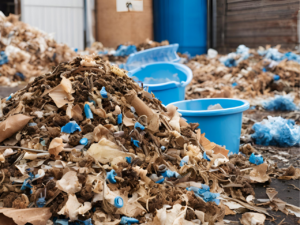Up to 40%* of all landfilled waste takes up unnecessary space, as it is actually both organic and biodegradable. This so-called “organic waste,” which includes food, garden, and agricultural waste, makes up a significant portion of municipal solid waste in South Africa.
“This is an opportunity that has to be tapped into,” says Mpendulo Ginindza, Past President of the IWMSA. “The correct treatment of organic waste matters. It protects the climate by reducing methane emissions from our landfills, reduces waste, recycles organic materials into valuable compost, and creates green jobs.”National and Municipal Approaches Needed
The government has implemented several initiatives to address the problem, including the National Environmental Management Waste Act (NEMWA), which encourages waste diversion from landfills through recycling, composting, and anaerobic digestion.“Composting is seen as a cost-effective method of organic waste diversion,” Ginindza explains. “However, municipalities are also required to develop integrated waste management plans that include organic waste, but these are often not executed to their full potential.”Developed countries around the world have a national framework in place mandating organic waste diversion from landfills — something that could make a big difference on home soil. Ginindza points out that some local urban areas do, however, show promising initiatives. The Western Cape and Gauteng have more developed organic waste recycling programs, with food waste and garden waste collection initiatives. “The Western Cape region has a complete organic waste diversion target of 2027. Since 2022, home composting efforts have increased, with the City of Cape Town rolling out home composting bins and raising awareness of the importance of composting.”
Organic Waste: Challenges and Solutions
According to Ginindza, there is no single challenge that hinders South African municipalities from implementing large-scale organic waste diversion programs.“Rather, it is a range of issues, including the implementation of the National Organic Waste Strategy, economic and financial viability, behavioral change, and investment mechanisms,” she explains.
Making a few key changes, however, could support the transformation of organic waste into resources like compost, biofuel, or energy. “Composting can be performed in a less costly open window system operating on a floor slab (open) or sheltered concrete bay (bay composting) with a common set of mechanised equipment,” she explains. “In-vessel composting systems operate in a tunnel or drum. Anaerobic digestion (AD) treatment, in different technical variants, involves bacterial decomposition of waste in the absence of oxygen to produce biogas, and mechanical biological treatment (MBT) often requires multiple components and processes with varying costs.” The cost factor of implementing programs like these can be tackled by thinking innovatively about partnerships between municipalities, private sector entities, and communities. “A multi-faceted approach would involve collaboration, incentives, and shared responsibility,” Ginindza explains. “Through Public-Private Partnerships (PPPs), contracting out services, and joint ventures, municipalities can collaborate with private firms to build composting facilities, anaerobic digestion plants, or biogas plants using municipal land and private investment.” She says in their goal to attract private sector involvement, municipalities can offer incentives that align with sustainability goals. “Implement tax rebates or reductions for companies that invest in organic waste recycling infrastructure or offer waste collection and processing services. Green certifications or public recognition can be given to companies participating in organic waste management projects, which can enhance their brand value and corporate social responsibility (CSR) reputation.” *According to an audit by the CSIR







